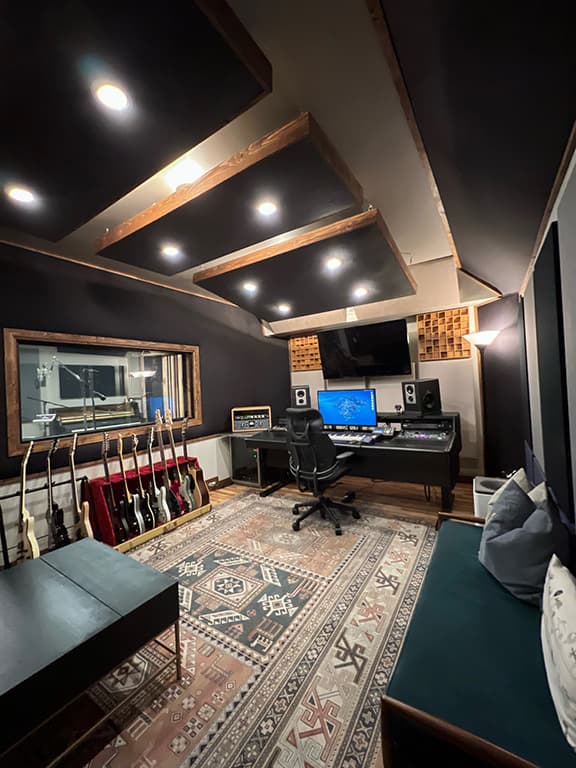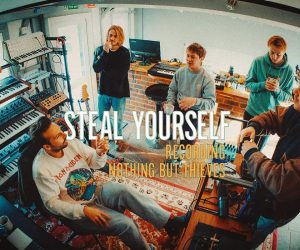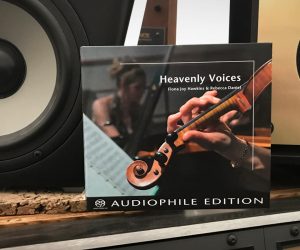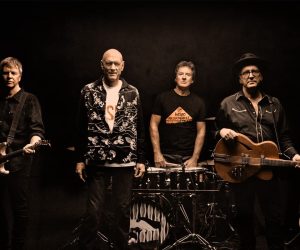
Recording Spiritbox
Recording Phasmophobia and beyond. An interview with producer/engineer Daniel Braunstein.
The world of heavy metal has been turned upside down by the arrival of Spiritbox. The Canadian band has been called ‘Metal’s Hottest Band’ and ‘The New Face Of Metal Music’, and their debut album, ‘Eternal Blue’, released last September, “a masterpiece of modern heavy music”. The album went to No.1 on the US Top Rock & Hard Rock charts, and also had an impact on the mainstream charts, reaching to No.8 in Australia, No.13 in the US and No.17 in Canada.
Spiritbox’s ascent to the big time was the result of a clever campaign of drip-drip release of singles, starting in 2017 with ‘The Beauty of Suffering’, leading to their very heavy sounding breakthrough single ‘Holy Roller’ in 2020, followed by ‘Constance’, and this year ‘Circle With Me’.
Each single showed different aspects of the band’s music, which encompasses an astonishing amount of genres. Within the metal genres itself Spiritbox works with metalcore, post-metal, djent, alternative metal, and progressive metal ingredients, but their music is also deeply influenced by electronica and sections of some of their songs sound like the pop/R&B that dominates the regular pop charts.
One ear- and eye-catching aspect of the band is lead singer Courtney LaPlante, who switches between clean, almost folk-like vocals and the guttural screaming that is the hallmark of much heavy metal. The songs on ‘Eternal Blue’ are co-written by her with her husband and guitarist Michael Stringer, bassist Bill Crook, and producer Daniel Braunstein, who helped the band sound, as one reviewer had it, “like multi-platinum superstars.”
I had to mix the album on the Bose headphones! Over the weeks that it took me to do the final mixes, I tried to gradually wean myself off

STAYING ON TRACK
From his The Hallway studio in Los Angeles, Braunstein acknowledges that the band and he are “extremely excited” about Spiritbox’s success so far. He was involved with the band from its beginnings in 2017, initially mixing and mastering their material, and from 2019 onwards also engineering sessions, producing and helping the band with songwriting and defining their sound. When the entire album project was thrown into chaos because of the pandemic, Braunstein was instrumental in keeping it on track.
Braunstein’s involvement with Spiritbox was based on his track record as a rock and metal producer, in part with his former band Volumes, and also producing rock acts like Silent Planet and Dayseeker, and even an indie pop act like Emotional Oranges. Braunstein grew up in LA, learned to play piano, violin and guitar, played in bands, and recorded them on his mother’s 4-track TEAC tape recorder. Following this, Braunstein did a Recording Arts degree at Loyola Marymount University, and after completion, in 2012, set up The Hallway recording studio. In 2018, he partnered with Zach Tuch, and each of them now have their own control room and live room inside their facility.
“My set up is pretty simple,” explains Braunstein. “I have a 500-series rack, with some API 512c mic pres, which get mostly used for DI, two Avedis MA5 mic pres, a UA 610, a Retro STA Level compressor, Empirical Labs Distressor, Apollo 16 interface, and Barefoot Footprint01 monitors. My main microphones are a Pearlman TM-1, which is a U47 clone, and a Bock 195. It sounds similar to the Neumann U87, a bit dryer, and the big transformer smoothes out the sizzling top end that U87s tend to have. I used this microphone on Courtney’s normal vocal for the Spiritbox record, and a Shure SM7b for the screaming.”
MASTERING ALL TRADES
When Braunstein and Spiritbox started work on ‘Eternal Blue’, in 2019, the producer would regularly fly to Canada. “Mike and Courtney live in Victoria, on Vancouver Island in British Columbia. I’d set up a studio in their house, and we would write and record the songs there, and I’d mix them back in my studio. The writing process with them is really fluid. Mike and Courtney are amazing writers, and we all click together. Sometimes Mike brings in an idea, and I add the production, and then Courtney adds her vocals. Sometimes I bring in a song starter idea, and Mike will write guitar parts to that.
“In most projects I work on, I co-write, produce, engineer and mix, and often I’ll master as well. These things go hand-in-hand these days, because it’s so easy to do everything with the technology. You don’t need to have a producer sitting on a couch and an engineer sitting at the desk and then send what you have done to a mixer anymore. And as a musician, I’m involved in the writing process. On top of being a guitar player, I’m also a piano player and a drummer. I’ll start song ideas by programming drums, or with a synth line, or by pulling in a sample and chopping that up.
“My main tool for creating song ideas is Ableton. Although I use Pro Tools for recording and mixing, I’ll rarely start an idea that way. Ableton is much quicker and much more flexible. The time between having an idea and it being fully realised is much shorter with Ableton. It is almost like an instrument. Inside of Ableton I often use Spectrasonics Omnisphere and Xfer Serum. Sometimes I find samples or loops on Splice.com. I also use Spectrasonics Keyscape a lot, as well as the Arturia V Collection, and Spitfire, plus the Output stuff like Signal, Exhale, Substance, and Analogue Strings.”
JAMMING ON ZOOM
According to Braunstein, LaPlante, Stringer and he started co-writing songs like ‘Holy Roller’, ‘Constance’ and ‘Blessed B’ “from scratch, sitting in a room together”. And then, the pandemic hit, and the company had to figure out how to continue working together, despite being physically separated. “We had this catalogue of songs we had started, and we wanted to finish them and continue to release singles, and eventually, of course, the album. We decided to begin with finishing ‘Holy Roller’, which is their craziest, heaviest song, with all screaming.
“Finishing that song was the first thing we did via Zoom, using AudioMovers. Mike normally uses Reaper, but for these sessions he got a copy of Pro Tools Ultimate and also loaded that on his computer. Via Zoom I then controlled his computer, and did the vocal recordings and production remotely. We also continued writing remotely, with him sending me riffs and I’d add something and send that back. We wrote a couple of songs via Zoom in real time, with both of us playing.”

DESERT SOUNDS
Come 2021, everyone was getting frustrated with working remotely. Because Braunstein could still not go to Canada, Spiritbox decided that the solution was for them to come to the US. “They rented an awesome house called Old Heard Ranch close to the Joshua Tree National Park, where we stayed for the whole of February 2021 — Courtney, Mike, [bassist] Bill Crook, and I. The property is on 26 acres of grounds, and the surroundings look like a different planet, with giant rock formations everywhere. We really felt like we were in the middle of nowhere.
“For all of us it was about the experience of how cool the place was, and the fact that we were finally able to sit in the same room together for the first time in a year! It’s only a couple of hours from Los Angeles, so I brought my Barefoot monitors, Avedis mic pres, Sta Level compressor, Bock microphone, MIDI keyboard, computer screen and laptop, and all the necessary headphones, headphone mixers, mic stands, cables and so on. They brought their Apollo Quad interface.”
“Like before, we did all Mike’s guitars DI, using the Neural DSP Archetype Nolly plugin, which we basically used as an amp. The Neural DSP amp simulations sound better than real amps 90% of the time. Plus I’m able to be so much more creative during the mix when I have the guitar DI at my disposal. If I wanted to pitch shift a note, which we did all over the place, I can do that with the DI recording, and it will not sound weird.
“Mike also played the basses, because when one pair of hands plays all the rhythm instruments, it creates a certain sound. On top of that, Mike and I write drum parts together, and the drummer would play those parts on an electric kit, and he’d send the recordings back. I then quantised them 90-95%, so the end result is a hybrid of programmed drums and a real drummer playing those programmed drum parts.”

CIRCLE ROUND
In contrast with the relaxing natural surroundings at Old Heard Ranch, Braunstein was at full stretch. “It was a lot of work. When we arrived we did not have an entire album of material written. We had maybe nine or 10 song ideas that we started with, and went from there. At one point Mike kept saying that we needed an extra song, a heavy-hitting banger, and he looked at this song starter idea of mine that had been lying around for a while. On February 14th, I went to LA for one day to be with my girlfriend, and when I came back, Mike had written a song to it, which was ‘Circle With Me’.
“We completed the recordings for the song the next day. We were inspired. That was really cool about living together: every time someone had a spark of inspiration, we could just record it right there and then. You can hear those magical moments on the album. We did have a routine, though, which is that during the day I usually worked with Mike, on instrumental parts; in the afternoon we’d go on outings; and in the evening I’d work with Courtney, laying down vocals. We made a make-shift vocal booth for her with a reflection filter from Amazon. I knew we had everything to get good quality dry recordings, despite the fact the acoustics in the dining room were terrible!
“Most of my time was spent sitting with the gear at the dining room table! Keeping track of everything was an enormous amount of work, and I kept saying that next time I’d bring an editing assistant! We had so much to do that we completed work on the album by the skin of our teeth when the month was over. One of the consequences of the bad acoustics was that I did not use the Barefoots very much. I only used them for moments when the entire band wanted to blast music, instead, for most of the time, I had to use headphones.”
MONITORS V HEADPHONES
After the sessions at the Ranch, Braunstein returned to The Hallway for final mixdown of all the material. It turned out that the dining room acoustics led to an unexpected hurdle that directly affected his mix process.
“The headphones I almost constantly used at the ranch were my wired Bose QuietComfort 25 Noise Cancelling headphones. I used them so much that I went out and bought a bunch more! I did all the pre-mixing on them while at the ranch, and when I sat down to mix in my studio and listened to the songs through my speakers, my ears were confused. I was totally disorientated. Going from headphones to speakers was a totally different experience. It’s something about the wideness that you get when working in headphones.
“I did some mixes on my speakers and sent them to Mike, and he said, ‘this does not sound right’. It just sounded totally different and Courtney’s vocals were way too loud. So I had to mix the album on the Bose headphones! Over the weeks that it took me to do the final mixes, I tried to gradually wean myself off the headphones. It wasn’t until the very end, when the band came over to my studio to do revisions in person, that I was able to lay the final hands on the mixes using my monitors.”

CLARITY V VIBE
Braunstein’s ‘headphone versus speaker’ issue clearly was not only due to the fact his ears had grown accustomed to the Bose headphones during the month, but also because he had already developed his rough mixes at the Ranch to a large degree.
“When I came back to The Hallway, he could not restart the mixes from scratch. Essentially what I ended up doing was simply refine what I already had. I tried to make everything more precise. The other general mix challenge was to get Courtney’s vocal to sit in the right place, with the guitars and all the atmospherics, while still retaining clarity.
“The latter challenge was in part to do with the fact that we like to put cool ethereal backgrounds in the music, which consist of almost dissonant melodic elements like drones, or an ambient piano or synth, often things with lots of reverb. They make the tracks sound really full, and the band really wanted these elements, but naturally the downside is that you get a lot of frequency masking. All this beautiful ambience can destroy the clarity in your mix. So for me the mixes were a constant battle between clarity and vibe.”
As Braunstein set about “refining” his rough mixes, he mixed with all tracks in. “I am pretty against soloing when mixing. I have ruined too many mixes doing that. I’ve learned that when you focus on one thing at a time, when you then put everything together, it usually doesn’t work. Mixing is about sounds relative to each other. It’s an exercise in condensing many things into one stereo file. You’re never going to hear all these things individually.
“I don’t want to put the process before the result, because only the results matter. So when I mix I want to hear the result all the time. I want to listen as a listener the whole time. For this reason I will also rarely loop sections while mixing. I’ll normally listen to the whole song from start to finish, and then I go back to the beginning and do it again. I’m very aware that your ears get used to things and you stop having an objective view of what’s happening.”


























RESPONSES